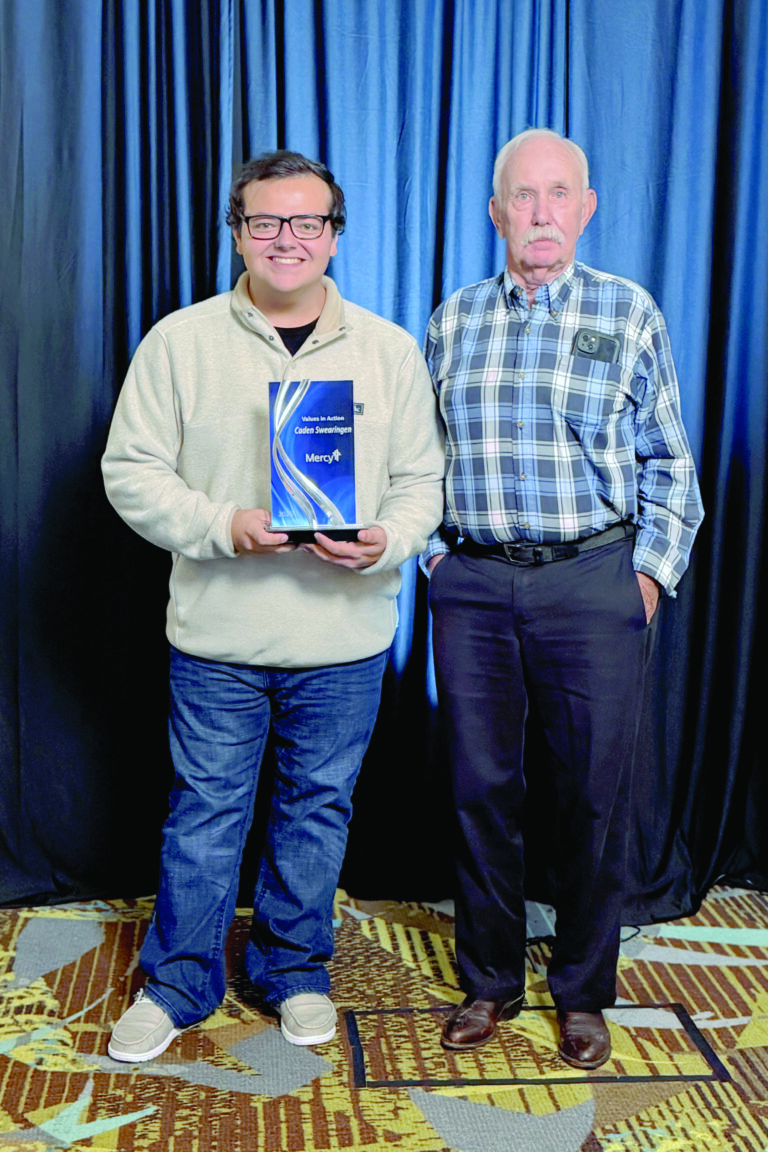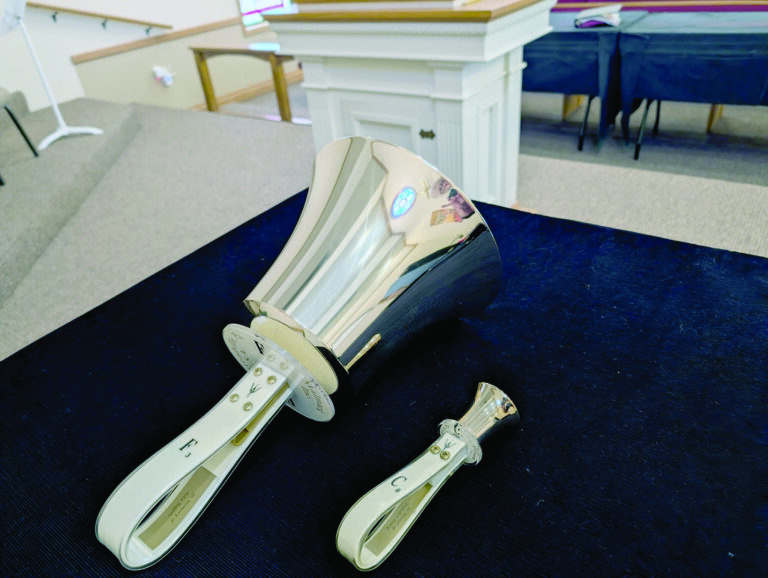Dye-tracing scientists present findings
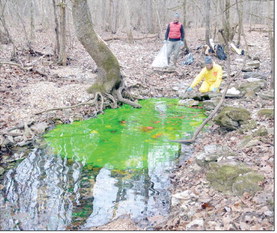
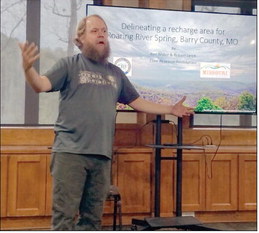
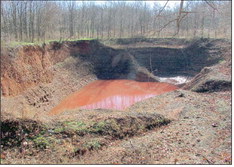
A five-year project to delineate Roaring River Spring’s recharge area is complete.
Ben Miller, hydrologist and Cave Research Foundation (CRF) volunteer, was at the Emory Melton Inn and
Conference Center in Roaring River State Park on April 18, where he presented information about the study, which he and co-CRF volunteer, Robert “Bob” Lerch completed in late 2023.
“This was by far the largest dye-tracing project I’ve worked on,” Miller said.
Miller, of Nashville, Tenn., and Lerch, of Columbia, made periodic trips to Barry County over a five-year period to inject non-toxic, fluorescent dyes into 43 sites within an ever-expanding circle around Roaring River Spring.
Miller said he and Lerch began their dye-tracing project in 2018 in partnership with Missouri State Parks and with the help of Roaring River State Park personnel. The study was funded by a grant from the
Cave Research Foundation, a non-profit organization “dedicated to facilitating research, management and interpretation of caves and karst resources,” as well as “to form partnerships to study, protect and preserve those resources” for their long term conservation.
Miller said Roaring River Valley and the spring that feeds the river are unique among karst features, and are worthy of protection.
A native of Springfield, Miller is well-versed in the karst hydrogeology of the Ozarks, which allows water to travel freely through what he calls a vast “underground plumbing system,” characterized by sink holes, caves, springs, losing streams and blind valleys.
“The results of our study show that Roaring River Spring draws water from a 47.34-square-mile area, with
the farthest point located at the headwaters of Shoal Creek [west of Exeter along State Hwy. 76/86],” Miller said.
That point is some 15 miles from Roaring River Spring. (A March 5 article in the Cassville Democrat erroneously reported that the furthest point was near Wheaton, some 25 miles from the spring.)
For the deepest explored spring in Missouri (472 feet and counting), the breadth
of its recharge area is not unexpected, Miller said.
“Having knowledge of the size and area of the spring’s recharge area can help landowners plan for the best use of their land,” he said.
Miller and Lerch’s approach to the dye-tracing project was systematic.
Four or five sites at a time were chosen for injection with different colored dyes. From those points, in theory, the dyes would make their way through underground waterways and show up in Roaring River Spring, where teabag-sized, crushed-charcoal packets were in place to absorb them. The charcoal receptors were then sent to labs to determine whether traces of the dyes existed and what colors, which in turn determined their points of origin. If dyes were detected, Miller and Lerch scouted out new injection sites beyond the first sites and farther away from the spring.
Miller gives credit to the Missouri Geological Survey for donating its resources for most of the lab analysis required.
“Lab analysis is the most expensive part of a project,” he said.
According to Miller, the amount of time it takes the dye to be flushed through surface and underground waterways to the spring varied, depending on the location of the injection site and the amount of rain an area received.
“We injected our first sites in 2018, then we had a seven-month drought, so we didn’t learn anything for months,” Miller said.
Miller and Lerch injected stream beds and other karst features (sinkholes and caves) closest to Roaring River Spring first, then work their way outward.
“Surprisingly, dye injected into most of the nearby sites never made it to the spring, but dye injected farther away did,” he said. “We think it’s because Roaring River is such a deep spring that the dye didn’t make its way down fast enough to be traceable.”
Miller said dye injected into a karst feature near the spring called the Farwell Hole did show up in the spring, though.
“The hole is essentially a vertical shaft, so we think it allowed the dye to sink deeper and at a faster rate,” Miller said.
From the injection sites nearest the park, Lerch and Miller began scouting for their next targets: sinkholes, creeks, losing streams (often called dry creek beds) or even puddles alongside the road.
Miller said sites up Dry Hollow and along areas of Flat Creek nearest to Roaring River Spring were heavily injected, with most of the results coming back positive.
“As an injection site, a dry creek bed is a smoking gun,” Miller said. “If there’s no water in it, it’s a sign that water has gone underground. Those are the kind of sites we like to test.
“We prefer to inject dye into wet streams or right before a rain, so we’ll know the dye isn’t just going to lie on the ground and go to waste.”
Sunlight can destroy the dye, Miller said.
Miller said he and Lerch accepted help from the Exeter and Jenkins Volunteer Fire Departments on a couple of occasions.
“The Exeter Fire Department flushed water into a dry creek bed, for us, so we’d know our dye would go somewhere,” Miller said.
In Rockhouse Creek Valley, some seven or eight miles northeast of Roaring River Spring, Miller and Lerch encountered an anomaly: a smallish sinkhole, just a few yards in diameter, that slurped water from a firehose so quickly that it never reached the dye in the center of the hole.
“The Jenkins Fire Department helped us at that site,” Miller said. “We ended up making a hose extension out of a piece of culvert-pipe and managed to direct the water into the center of the hole, where it drained so fast that it created a vortex.”
Dye from that trace reached Roaring River Spring, Miller said. Rockhouse Creek Valley proved to be the northeastern-most point of the spring’s recharge area.
Miller said part of the challenge of the Roaring River Spring dye-tracing project was tracking down private landowners and asking for permission to inject dye into creeks or sinkholes on their land.
“Once we explained, most people were agreeable to it,” Miller said. “It’s always a good idea, anyway, to let people know about the nature of the project. We’ve had cases of people calling their local law enforcement and health departments about alarming changes in the color of water in creeks and sinkholes.”
Miller referenced the Exeter landowner who contacted The Cassville Democrat when water in a notorious karst feature, the Exeter Sinkhole, turned bright red.
“We had just injected Rhodamine dye into a public ditch uphill from the sinkhole,” Miller said.
Miller said dye from that sinkhole showed up to the southwest, in Thomas Hollow, where a charcoal packet had been placed.
South of Seligman, in Butler Hollow, dye injected into a karst feature called the “Mosquito Squadron Pit” showed up in both Roaring River Spring, to the north, and Blue Spring, near Eureka Springs, Ark., to the southwest. Miller said it had to flow beneath the White River to do so.
“Six different traces ran below the White River to show up in Blue Spring,” Miller said.
Miller called it one of the most fascinating discoveries of their project.
Research of the entire Blue Spring recharge area has never been conducted, Miller said.
“We finally had to walk away from that area, since our goal was to delineate Roaring River Spring’s recharge area,” he said.
Miller said even though he and Lerch are calling their Roaring River project complete, it’s possible that there are other points from which dye could reach the spring, if they were injected.
“Our results show the known scope of Roaring River Spring’s recharge area,” Miller said. “It provides enough information for landowners above and around the spring to make informed decisions about best land-use practices.”
Roaring River Valley’s unique karst characteristics, said Miller, are due to the valley’s location along the Eureka Springs Escarpment, the jagged division of the younger and taller Springfield Plateau (upon which Washburn, Cassville and northern Barry County sit), from the older and settled Salem Plateau to the east. According to Miller, the abrupt drop to the valley floor – actually part of the Salem Plateau – is common along the Eureka Springs Escarpment.
“It’s an area worth protecting,” he said.


